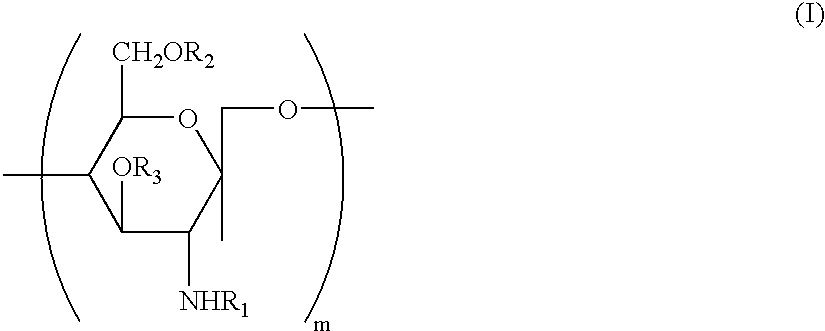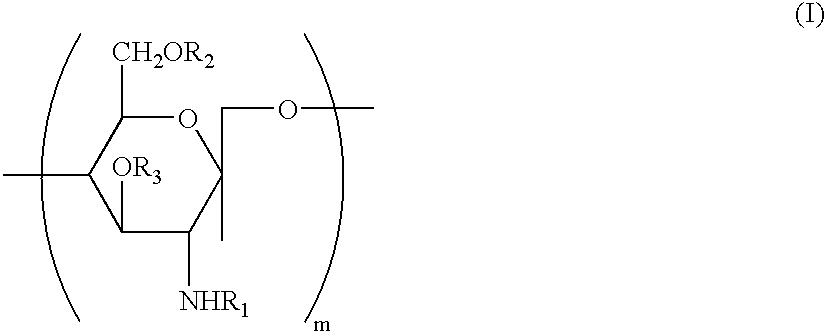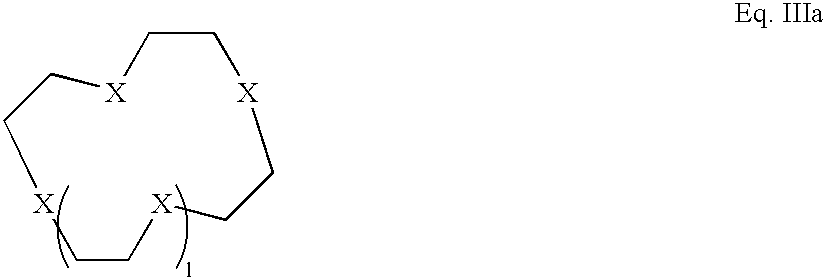Water soluble, randomly substituted partial N-partial O-acetylated chitosan, preserving compositions containing chitosan, and processes for making thereof
a technology of chitosan and chitosan, which is applied in the field of water-soluble chitosan preserving compositions, can solve the problems of affecting the preservation effect of chitosan, and affecting the preservation effect of chitosan, and achieves the effect of minimal preservation activity
- Summary
- Abstract
- Description
- Claims
- Application Information
AI Technical Summary
Benefits of technology
Problems solved by technology
Method used
Image
Examples
example # 1
Example #1 was evaluated using the described lysozyme assay in comparison to several commercial contact lens multi-purpose solutions, and the results from the assay represented in Table 1-b indicate that only Example #1 prevented lysozyme denaturing.
Ocular irritation and in vitro biocompatibility was also evaluated for the Example 1 formulation. The degree of ocular irritation and epithelial cell layer staining was evaluated in 6 rabbits in accordance with methods proposed by Draize J H, Woodard G, and Calvery H O: Methods for the Substances Applied Topically to the Skin and Mucous Membranes. J. Pharmacol. Ext. Ther. (1944)82: 377-390. After a preliminary examination and Draize scoring of both eyes, each rabbit received eight (8) hourly 10 microliter instillations of Example 1 to the surface of the right eye only, with the left untreated eye serving as a control. Within 1 hour after the last application of test solution and again after 24, 48 and 72 hours, all eyes were evaluated in...
example 2
This example illustrates the activity of different hydroxyalkyl chitosan solutions against Escherichia coli in a 28 day USP Preservative Efficacy Test (PET). Solutions 2a-e were prepared as described in Example 1, using the following recipe.
example formulations # 2a-e
Example Formulations #2a-e
0.05% EDTA
1.00% Boric Acid
Ultrapure Water (q.s. adj 100.00 mL)
0.5M Sodium Hydroxide(q.s. adj pH=6.9)
Sodium Chloride (q.s. adj mOsm=300)
a: control; b=0.25% glycol chitosan (SIGMA Chemical); c=0.25% hydroxypropyl chitosan (Austin Chemical Co.); d=0.25% hydroxybutyl chitosan (Austin Chemical Co.); e=0.25% di-hydroxypropyl chitosan (Technology Resource International Corporation).
The conditions of the PET were the same as those for Example 1 except that a re-challenge inoculum was not introduced at day 14. For this test, E. coli only was chosen as the screening microorganism because earlier tests showed that it was typically more resistant than other PET bacteria to chitosan antimicrobial formulations. Thus, antimicrobial activity against E. coli was deemed predictive of efficacy against the other PET microorganisms.
Referring to Table 2, it can be seen that all of the test solutions met the requirements of the USP PET for E. coli, namely that the number of viabl...
PUM
| Property | Measurement | Unit |
|---|---|---|
| pH | aaaaa | aaaaa |
| time | aaaaa | aaaaa |
| time | aaaaa | aaaaa |
Abstract
Description
Claims
Application Information
 Login to View More
Login to View More - R&D
- Intellectual Property
- Life Sciences
- Materials
- Tech Scout
- Unparalleled Data Quality
- Higher Quality Content
- 60% Fewer Hallucinations
Browse by: Latest US Patents, China's latest patents, Technical Efficacy Thesaurus, Application Domain, Technology Topic, Popular Technical Reports.
© 2025 PatSnap. All rights reserved.Legal|Privacy policy|Modern Slavery Act Transparency Statement|Sitemap|About US| Contact US: help@patsnap.com



